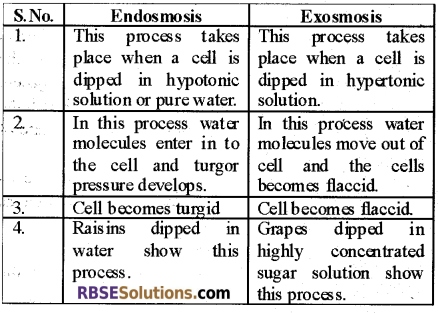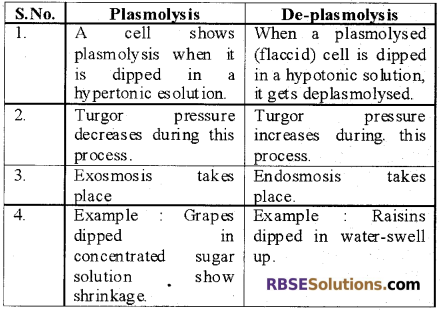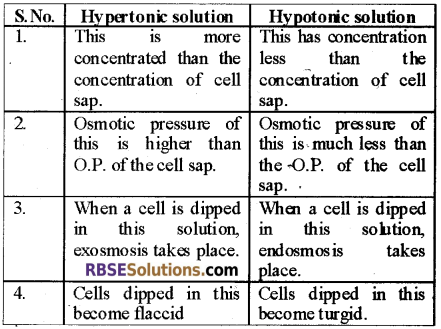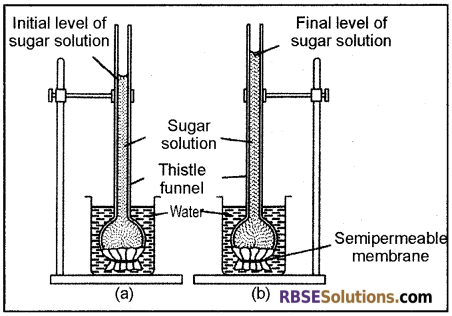Rajasthan Board RBSE Class 12 Biology Chapter 5 Plant Water Relations
RBSE Class 12 Biology Chapter 5 Multiple Choice Questions
Question 1.
The process of exchange of \({ CO }_{ 2 }\) and \({ O }_{ 2 }\) from the atmosphere by the leaves is called?
(a) Osmosis
(b) Diffusion
(c) Imbibition
(d) Endosmosis
Answer:
(a) Osmosis
Question 2.
Which of the following is permeable?
(a) Plasma membrane
(b) Tonoplast
(c) Cuticle
(d) Cell wall
Answer:
(d) Cell wall
![]()
Question 3.
The value of DPD in the flaccid state will be?
(a) Equal to OP
(b) More than OP
(c) Zero
(d) Less than OP
Answer:
(a) Equal to OP
Question 4.
In the flaccid state the value of which pressure is zero?
(a) Suction force
(b) Diffusion pressure
(c) Wall pressure
(d) Osmotic pressure
Answer:
(c) Wall pressure
Question 5.
The process of swelling of hydrophilic substances by adsorption of water or moisture is called –
(a) Imbibition
(b) Osmosis
(c) Diffusion
(d) De plasmolysis
Answer:
(a) Imbibition
RBSE Class 12 Biology Chapter 5 Very Short Answer Questions
Question 1.
Write an example of a semi-permeable membrane.
Answer:
The lipo-protein cell membranes are semipermeable in nature.
![]()
Question 2.
Write one importance of osmosis.
Answer:
Absorption of water from the soil by root hairs takes place by osmosis. Similarly, the movement of water from one cell to another in the plant body is also by the process of osmosis.
Question 3.
Define diffusion.
Answer:
The movement of molecules of a substance from the region of their higher concentration to the region of their lower concentration is called diffusion.
Question 4.
Define imbibition.
Answer:
Adsorption of water by the colloidal and solid substance without forming solution is called imbibition.
Question 5.
Explain T.P., W.P.
Answer:
The pressure developed on the cell wall by stretching of the cell membrane or plasma membrane of a turgid cell is called turgor pressure. The pressure developed by the cell wall on the cytoplasm in opposite direction against the turgor pressure is called wall pressure.
RBSE Class 12 Biology Chapter 5 Short Answer Questions
Question 1.
Explain the water potential.
Answer:
The difference between the free energy of water molecules in pure water and the free energy of water molecules present in a solution is called water potential.
This is expressed by Greek symbol ψ(Psi).
The unit of water potential is pascal (Pa).
![]()
Water potential (ψ) = [Free energy of molecules of pure water] – [Free energy of water molecules of a solution]
According to the modern concept, D.P.D. is expressed as water potential (\({ \Psi }_{ w }\)), osmotic pressure (O.P.) is \({ \Psi }_{ s }\): expressed as osmotic potential (\({ \Psi }_{ s }\)) and turgor pressure (T.P.) is expressed as pressure potential (\({ \Psi }_{ p }\)).
Accordingly relation between water potential, osmotic potential and pressure potential is expressed as follows:
Water potential = Osmotic potential + Pressure potential
\({ \Psi }_{ w }\) = \({ \Psi }_{ s }\) + \({ \Psi }_{ p }\)
The value of water potential (\({ \Psi }_{ w }\)) and osmotic potential (\({ \Psi }_{ s }\)) is negative whereas the value of pressure potential \({ \Psi }_{ p }\) is positive. The maximum value of water potential zero.
Question 2.
Differentiate between endosmosis and exosmosis.
Answer:

Question 3.
Explain the difference between plasmolysis and de-plasmolysis.
Answer:

Question 4.
Differentiate between hypertonic and hypotonic solution.
Answer:

Question 5.
Explain the diffusion pressure gradient.
Answer:
DPD of a certain cell is the measure of the capacity of the cell to draw water from the surrounding. When the DPD of a cell [A] is higher than the DPD of an adjacent cell [B], Cell (A) will draw water from cell (B) till the DPD of the two cells becomes equal i.e. the state of equilibrium is reached This difference in the value of DPD between two cells results in to a deficiency gradient, which is called as diffusion pressure gradient.
![]()
Question 6.
Explain the diffusion pressure deficit.
Answer:
At normal temperature and atmospheric pressure, the difference between the diffusion pressure of a solution and the diffusion pressure of pure water is called DPD. In fact, DPD of a cell is the measure of the force by which the cell can draw water, hence it is also called suction pressure.
Question 7.
Giving example, explain inhibition.
Answer:
Imbibition is a physical process. It is a process in which solid or semisolid organic compounds draw water from their surrounding and swell up but do not dissolve in water. The chemicals which show this property are called inhibitants. These substances are generally hydrophilic in nature. Due to the attraction between the molecules of hydrophilic substances and water molecules, plant cell wall, seeds and wood etc. draw water and swell up. The pressure developed due to imbibition is called imbibition pressure (IP). Imbibition pressure is equal to osmotic pressure. It is an exothermic process.
Examples:
- The wooden doors and windows swell during rainy season due to this process.
- Seeds swell up due to imbibition of water.
- In the epiphytes, the hygroscopic nature of roots draws water by this process.
- In many dry fruits and sporangia, dehiscence is by this process.
- The imbibition pressure has been used to break large-sized rocks.
RBSE Class 12 Biology Chapter 5 Essay Type Questions
Question 1.
Describe osmotic potential, pressure potential and water potential and explain their mutual relationship.
Answer:
- The hypothesis of water potential was proposed by Slatyer and Taylor (1960). According to laws of thermodynamics, each component of any system has some free energy which allows it to work.
- During osmosis water molecules move across the semipermeable membrane and for this free energy is required. When a cell is kept in pure water, there exists a difference of free energy between molecules of pure water and the free energy of water molecules present in the solution.
- This difference of free energy between the pure water and water molecules of the solution is called water potential.
- In other words, the value of water potential of a solution is equal to the difference in the value of free energy of solvent molecules of the solution and free energy of molecules of the pure solvent. It is expressed by Greek symbol ψ(psi) and its unit is Bar or atm.
- It is not possible to determine the absolute value of water potential and hence its value is taken as zero. Free energy of pure water (solvent) is maximum and when some solute is added to it, the free energy of solvent (water) decreases.
- Hence free energy of any solution is less than that of pure water meaning by always negative.
![]()
According to laws of thermodynamics:
- DPD of a solution is equal to the water potential but the value of DPD is positive and that of water potential is negative.
- OP is called solute potential or osmotic potential and it is expressed as \({ \Psi }_{ s }\). The value of osmotic pressure and the osmotic potential is equal but the only difference is that the value of osmotic pressure is positive and that of osmotic potential is negative. Its value is also negative.
- TP is called pressure potential and it is expressed as \({ \Psi }_{ p }\). Value of pressure potential is positive.
According to this hypothesis relationship between water potential, osmotic potential and pressure potential is as follows:
\({ \Psi }_{ w }\) = \({ \Psi }_{ s }\) + \({ \Psi }_{ p }\).
Where
\({ \Psi }_{ w }\) = Water potential
\({ \Psi }_{ s }\) = Osmotic Potential
\({ \Psi }_{ p }\) = Pressure potential
here value of
\({ \Psi }_{ w }\) is negative
\({ \Psi }_{ s }\) is negative
\({ \Psi }_{ p }\) is positive
so
\({ \Psi }_{ w }\) = \({ \Psi }_{ s }\) + \({ \Psi }_{ p }\).
Concept of an Osmotic System:
- The concentrated sugar solution is filled in a bag made up of the semipermeable membrane.
- It is kept in a beaker containing dilute sugar solution.
- Water molecules from beaker begin to move to the concentrated solution in the bag through the semipermeable membrane.
- After some time, the bag stretches due to endosmosis. When the bag becomes fully stretched it creates pressure on the solution to prevent further entry of water. This pressure is called turgor pressure.
- The effect of turgor pressure on water potential is called pressure potential. In a plant cell, the cell wall is referred to as a matrix.
- In a fully turgid plant cell, the pressure developed by the cell wall is called matrix potential. It is represented as \({ \Psi }_{ m }\).
Although in the soil the matrix potential is important it is negligible in the cellular osmotic system.
Hence
Water potential \({ \Psi }_{ w }\) = \({ \Psi }_{ m }\) + \({ \Psi }_{ s }\) + \({ \Psi }_{ p }\)
As the value of \({ \Psi }_{ m }\) is negligible in a cellular system,
\({ \Psi }_{ w }\) = \({ \Psi }_{ s }\) + \({ \Psi }_{ p }\)
Since the value of \({ \Psi }_{ s }\) is negative and that of \({ \Psi }_{ p }\) is positive. So in a fully turgid cell when the value of \({ \Psi }_{ p }\) becomes equal to \({ \Psi }_{ s }\), further endosmosis stops and ψw becomes zero.
![]()
Question 2.
Defining the process of osmosis and describe an experiment by which it may be demonstrated.
Answer:
Osmosis:
Diffusion of only solvent molecules through the semipermeable membrane is called osmosis. Osmosis can be defined as “movement of solvent molecules from the region of their higher concentration to the region of their lower concentration across a semipermeable or selectively permeable membrane is called osmosis”.
- Osmosis is a special type of diffusion where a semipermeable membrane is necessarily present between two systems.
- The process can be understood and demonstrated with the help of a thistle funnel experiment.
- Parchment paper is properly tied over the broader face of the funnel.
- The tube of the funnel is then filled with a sugar solution and its level is made.
- The face of the funnel covered with parchment paper is kept in a beaker filled with water.
- After some time it is observed that the level of sugar solution in the tube of the funnel rises up.
- According to the process of osmosis, water molecules diffuse from the region of their higher concentrate (from beaker) to the region of their lower concentration (sugar solution in the funnel) whereas sugar molecules do not show diffusion because of the semipermeable nature of the parchment paper.

Types of Osmosis:
1. Endosmosis:
When a normal plant cell is dipped in a hypotonic solution or pure water, it is observed that water molecules enter the plant cell. This is called endosmosis. Inward movement of water in any system through osmosis is called endosmosis.
Example:
- Swelling of raisins dipped in water.
- The entry of soil water in root hair cells.
2. Exosmosis:
When a plant cell is dipped in a hypertonic solution (concentrated sugar solution) it is observed that water molecules begin to come out of cells. This is called exosmosis.
Example:
- Shrinking of grapes dipped in concentrated sugar solution.
- Adverse effect on crop plants of the addition of excessive chemical fertilizer in the soil.
![]()
Importance of Osmosis:
- Root hair absorbs water from the soil through osmosis. Plant Water Relations.
- Absorption of some dissolved minerals also takes place partly through osmosis.
- Turgidity of cells and growth of the young cells depend on osmosis.
- Transportation of water from one part of the plant to another and cell to cell conduction occurs through osmosis.
- Opening and closing of stomata are regulated by osmosis.
- Turgid state of the cells is responsible for specific shape and form of leaf, flowers and fruits etc.
- This process makes the plant resistant against freezing and desiccation.
- It is helpful in the germination of seeds.
Question 3.
Describing briefly the process of osmosis, diffusion and imbibition, explain their importance in plant physiology.
Answer:
Osmosis:
Diffusion of only solvent molecules through the semipermeable membrane is called osmosis. Osmosis can be defined as “movement of solvent molecules from the region of their higher concentration to the region of their lower concentration across a semipermeable or selectively permeable membrane is called osmosis”.
- Osmosis is a special type of diffusion where a semipermeable membrane is necessarily present between two systems.
- The process can be understood and demonstrated with the help of a thistle funnel experiment.
- Parchment paper is properly tied over the broader face of the funnel.
- The tube of the funnel is then filled with a sugar solution and its level is made.
- The face of the funnel covered with parchment paper is kept in a beaker filled with water.
- After some time it is observed that the level of sugar solution in the tube of the funnel rises up.
- According to the process of osmosis, water molecules diffuse from the region of their higher concentrate (from beaker) to the region of their lower concentration (sugar solution in the funnel) whereas sugar molecules do not show diffusion because of the semipermeable nature of the parchment paper.

Types of Osmosis:
1. Endosmosis:
When a normal plant cell is dipped in a hypotonic solution or pure water, it is observed that water molecules enter the plant cell. This is called endosmosis. Inward movement of water in any system through osmosis is called endosmosis.
Example:
- Swelling of raisins dipped in water.
- The entry of soil water in root hair cells.
2. Exosmosis:
When a plant cell is dipped in a hypertonic solution (concentrated sugar solution) it is observed that water molecules begin to come out of cells. This is called exosmosis.
Example:
- Shrinking of grapes dipped in concentrated sugar solution.
- Adverse effect on crop plants of the addition of excessive chemical fertilizer in the soil.
Importance of Osmosis:
- Root hair absorbs water from the soil through osmosis. Plant Water Relations.
- Absorption of some dissolved minerals also takes place partly through osmosis.
- Turgidity of cells and growth of the young cells depend on osmosis.
- Transportation of water from one part of the plant to another and cell to cell conduction occurs through osmosis.
- Opening and closing of stomata are regulated by osmosis.
- Turgid state of the cells is responsible for specific shape and form of leaf, flowers and fruits etc.
- This process makes a plant resistant against freezing and desiccation.
- It is helpful in the germination of seeds.
![]()
Diffusion:
- The movement of molecules of any substance (solid, liquid and gas) from the region of their higher concentration to the region of their lower concentration is called diffusion.
- The property of diffusion is found in the molecules, particles and ions of all solids, liquids and gases, but the rate of their diffusion is different.
- The diffusion of molecules or ions takes place continuously in all directions and they tend to spread evenly or uniformly in the available space.
- The property of movement of molecules of any substance is due to their kinetic energy.
- When a bottle of ammonia is opened in a room it is due to diffusion only that the smell of ammonia spreads in the entire room and when a crystal of copper sulphate is put in a glass of water entire water becomes blue coloured.
- In a system of two or more substances, the direction and the rate of diffusion of molecules of the substances does not depend upon each other. For example, when concentrated sugar solution and pure water are brought in contact, sugar molecules move towards the water and water molecules move towards sugаr solution.
- Diffusion of molecules of different substances present in a system depends on their concentration and is not influenced by the presence of other substance, this is called independent diffusion.
- Example: In plants diffusion of \({ O }_{ 2 }\), \({ CO }_{ 2 }\) and water vapour is not influenced by the presence and concentration of the molecules of one another but is rather influenced by the concentration of the molecules of that particular substance in the atmosphere.
Factors Affecting Diffusion:
(1) Temperature:
Rate of diffusion is directly proportional to temperature, i.e. increase in temperature increases the kinetic energy of molecules, resulting in to increase in the rate of diffusion.
(2) Density:
Rate of diffusion of a substance is inversely proportional to the square root of the density of the diffusing substance i.e. increase in the size of molecules reduces the rate of their diffusion. This means lesser is the size of molecules higher is the rate of their diffusion.

(3) Pressure:
Rate of diffusion is directly proportional to the pressure. Movement of molecules of any substance is always from the region of their higher diffusion pressure to the region of their lower diffusion pressure. In other words movement of molecules is from the region of their higher concentration to the region of their lower concentration.
(4) Medium:
Rate of diffusion is slower through a dense medium as compared to a sparse medium.
Importance of Diffusion:
- During photosynthesis and respiration exchange of gases (\({ CO }_{ 2 }\) and \({ O }_{ 2 }\)) between plants and atmosphere takes place through diffusion.
- During transpiration loss of water vapour from plant to the atmosphere is through diffusion.
- Passive absorption of minerals to some extent occurs through diffusion.
- Diffusion is also helpful in translocation of food material (from leaves to roots) in the plant body.
- Osmosis and inhibition also involve diffusion.
- Plant hormones are distributed in the plant body by diffusion.
![]()
Inhibition:
- Absorption of water molecules by solid or colloidal substances without forming solution is called Inhibition. In fact, this kind of absorption is called adsorption.
- In Inhibition colloidal substances and hydrophilic solid substances draw water. The substances which inhibit water are called Inhibition.
- Inhibitants are hydrophilic colloids and can inhibit a large amount of water by surface attraction.
- The primary and secondary wall layers of plant cells are made up of cellulose, pectin and lignin etc. These are hydrophilic in nature and can absorb a large amount of water.
- The rate of inhibition is affected by temperature, nature of inhibitant, and a difference in water potential.
- Inhibition can occur only when there is an affinity between the inhibitant and water.
- A considerable force may develop due to inhibition within the plant body. This is called inhibition pressure.
- In inhibition water always moves with some force from saturated region to drier region.
Importance of Inhibition:
- In germinating seeds, seed coat burst due to inhibition pressure.
- It also plays an important role (together with osmosis) in the intake of soil water by root-hairs.
- It is believed to be an important force involved in the ascent of sap. In many plants, resurrection is on account of the presence of hydrophilic colloids.